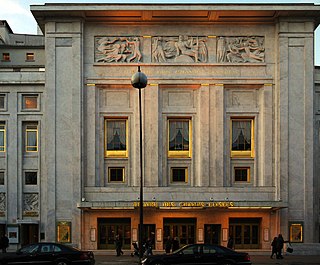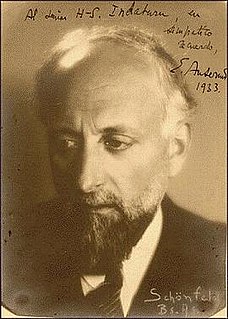
"Les Six" is a name given to a group of six French composers who worked in Montparnasse. The name, inspired by Mily Balakirev's The Five, originates in critic Henri Collet's 1920 article "Les cinq Russes, les six Français et M. Satie". Their music is often seen as a reaction against the musical style of Richard Wagner and the impressionist music of Claude Debussy and Maurice Ravel.

Francis Jean Marcel Poulenc was a French composer and pianist. His compositions include mélodies, solo piano works, chamber music, choral pieces, operas, ballets, and orchestral concert music. Among the best-known are the piano suite Trois mouvements perpétuels (1919), the ballet Les biches (1923), the Concert champêtre (1928) for harpsichord and orchestra, the Organ Concerto (1938), the opera Dialogues des Carmélites (1957), and the Gloria (1959) for soprano, choir and orchestra.

Concert champêtre, FP 49, is a harpsichord concerto by Francis Poulenc, which also exists in a version for piano solo with very slight changes in the solo part.

Les Mamelles de Tirésias is an opéra bouffe by Francis Poulenc, in a prologue and two acts based on the eponymous play by Guillaume Apollinaire. The opera was written in 1945 and first performed in 1947.
The Suite en 3 mouvements in C major, FP 19, is a suite for piano by Francis Poulenc which contains three movements:

Les biches is a one-act ballet to music by Francis Poulenc, choreographed by Bronislava Nijinska and premiered by the Ballets Russes on 6 January 1924 at the Salle Garnier in Monte Carlo. Nijinska danced the central role of the Hostess. The ballet has no story, and depicts the random interactions of a group of mainly young people in a house party on a summer afternoon.
Mouvements perpétuels, FP 14a, is a short three-movement suite for solo piano by the French composer Francis Poulenc, premiered in Paris in December 1918, when Poulenc was aged 19 and a protégé of Erik Satie. The work is dedicated to the artist Valentine Hugo and was first performed by Poulenc's piano teacher, Ricardo Viñes. From January 1918 to January 1921 Poulenc was a conscript in the French army, but his duties allowed him time for composition. He wrote the pieces at the piano of the local elementary school at Saint-Martin-sur-le-Pré.
Variations sur le nom de Marguerite Long is a collaborative orchestral suite written by eight French composers in 1956, in honour of the pianist Marguerite Long.
Suite française, FP 80, is an orchestral suite for wind instruments, drum and harpsichord by Francis Poulenc. It was composed in a neoclassical style in 1935 for Édouard Bourdet's la Reine Margot, and it was inspired by Claude Gervaise's dance collection Le livre de danceries.
L'Histoire de Babar, le petit éléphant, FP 129, is a composition for narrator and piano by Francis Poulenc, based on Histoire de Babar and written from 1940.

The Sonata for two clarinets, FP 7, is a piece of chamber music composed by Francis Poulenc in 1918. Dedicated to Édouard Souberbielle, its total execution time is about six minutes. It is quite unusual among clarinet duets in that it is written for B♭ clarinet, which generally plays the melodic themes, and A clarinet, which plays a more supporting role through much of the piece. It is also unusual for a duet, where the two clarinets are in different time signatures in parts of the first movement.

The Sonate pour clarinette et basson, FP 32a, is a piece of chamber music composed by Francis Poulenc in 1922. Its total execution time is approximately 7 to 8 minutes.

The Sonate pour violon et piano, FP 119, by Francis Poulenc was composed in 1942–1943 in memory of the Spanish poet Federico García Lorca. The score, dedicated to Poulenc's niece Brigitte Manceaux, was published by Max Eschig. The work was premiered by the violinist Ginette Neveu with the composer at the piano on 21 June 1943 in Paris, salle Gaveau.

The Music of Francis Poulenc (1899–1963): A Catalogue, abbreviated FP, is a chronological catalogue of Francis Poulenc's works which was published by Carl B. Schmidt in 1995. Schmidt provides for each known composition, which includes unfinished, unpublished and lost works, a detailed history of composition and performance, and lists manuscripts and publications.
Messe en sol majeur, FP 89, is a missa brevis by Francis Poulenc. He set most parts of the Latin mass to music in 1937, scored for a mixed choir a cappella.

Sécheresses (Drought), FP 90, is a cantata by Francis Poulenc for mixed choir (SATB) composed in 1937 on poems by Edward James who commissioned it. It was regarded as a failure when it was premiered in 1938, but a great success when it was performed again in 1953.
Les Soirées de Nazelles, FP 84, is a set of variations for piano written by the French composer Francis Poulenc. During the evenings, the composer used to sit at the piano and improvise "portraits" of his friends, all based on a given theme. The work was begun in 1930, and completed at Noizay on October 1, 1936. At the beginning of the score, it reads:
The variations that form the center of this work were improvised at Nazelles during long country evenings wherein the composer played "portraits" for friends gathered around his piano.
We hope that these variations, each one somewhere between a first draft and a finished work, will have the power to evoke this game in the spirit of a Touraine region living room– with a window open to the night.
The Sonate pour cor, trompette et trombone, FP 33a, by Francis Poulenc is a piece of chamber music composed in 1922 and dedicated to Raymonde Linossier (1897–1930). Poulenc revised it in 1945. Its total execution time is about eight minutes.














